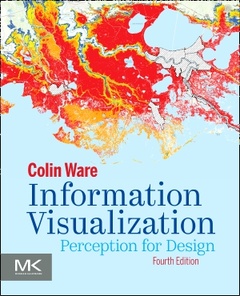Description
Information Visualization (4th Ed.)
Perception for Design
Interactive Technologies Series
Author: Ware Colin
Language: English
Subjects for Information Visualization:
Keywords
Visualization Stages; Semiotics of Graphics; Gibson’s Affordance Theory; Metadata; Optimal Display; Neurons; Receptive Fields; Brightness Illusions; Luminance; Brightness; Gamma Perception of Surface Lightness; Trichromacy Theory; Color Measurement; Opponent Process Theory; Tuned Receptors; Glyph Design; Searchlight Metaphor; Cortical Magnification; &; nbsp; Gestalt Laws; Perception of Transparency; Pattern Learning; &; nbsp; Depth Cue Theory; Task-Based Space Perception; Surface Morphology; Object Recognition; Concept Mapping; Scene Gist; Visual Narrative; Cognitive System; Knowledge Formation
560 p. · 19x23.4 cm · Paperback
Description
/li>Contents
/li>Readership
/li>Biography
/li>Comment
/li>
Information Visualization: Perception for Design, Fourth Edition explores the art and science of why we see objects the way we do. Based on the science of perception and vision, the author presents the key principles at work for a wide range of applications--resulting in visualization of improved clarity, utility and persuasiveness. This new edition has been revised and updated to include the latest relevant research findings. Content has been updated in areas such as the cognitive neuroscience of maps and navigation, the neuroscience of pattern perception, and the hierarchy of learned patterns.
New changes to the book make it easier to apply perceptual lessons to design decisions. In addition, the book offers practical guidelines that can be applied by anyone, including interaction designers and graphic designers of all kinds.
1. Foundations for an Applied Science of Data Visualization 2. The Environment, Optics, Resolution, and the Display 3. Lightness, Brightness, Contrast, and Constancy 4. Color 5. Visual Salience and Finding Information 6. Static and Moving Patterns 7. Space Perception 8. Visual Objects and Data Objects 9. Images, Narrative, and Gestures for Explanation 10. Interacting with Visualizations 11. Visual Thinking Processes 12. Designing for Perception (new)
Visual Thinking Algorithms Visual Queries Pathfinding on a Map or Diagram Reasoning with a Hybrid of a Visual Display and Mental Imagery Design Sketching Brushing Small Pattern Comparisons in a Large Information Space Degree-of-Relevance Highlighting Generalized Fisheye Views Multidimensional Dynamic Queries with Scatter Plot Visual Monitoring Strategies
APPENDIX A. Changing Primaries B. CIE Color Measurement System Techniques and Systems C. Guidelines
upper level undergraduate and graduate students taking data visualization courses in computer science, computer engineering, and physics departments; professionals in user interface/user interaction designer; computer graphics, research scientists and engineers; data miners; and managers faced with information-intensive challenges
- Includes the latest research findings in visualization and perception
- Provides a new chapter on designing for perception to help bridge the gap between specific perception-based guidelines and common design decisions
- Presents over 400 informative, full color illustrations that are key to an understanding of the subject




